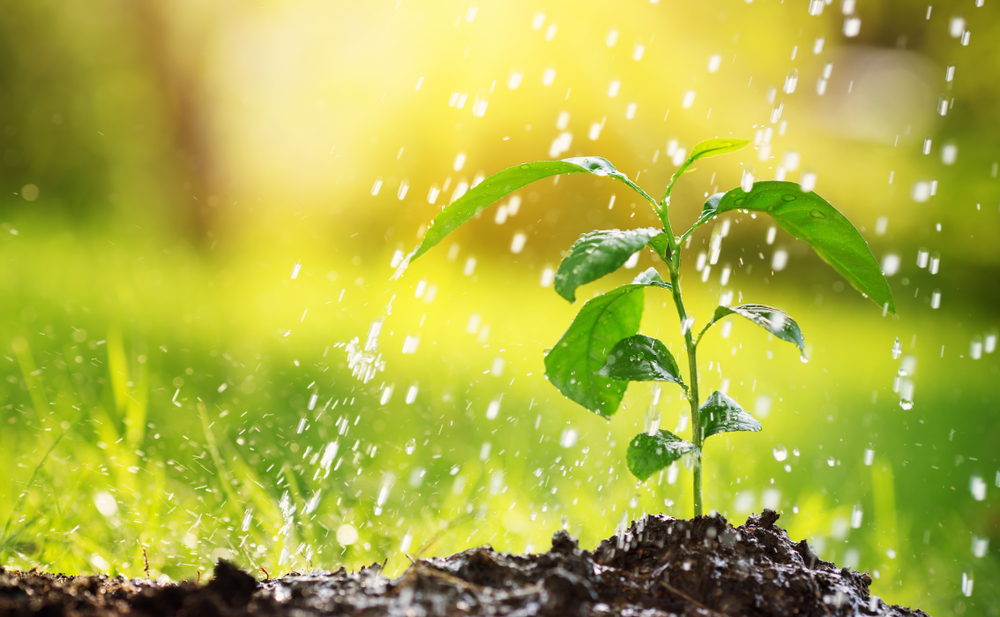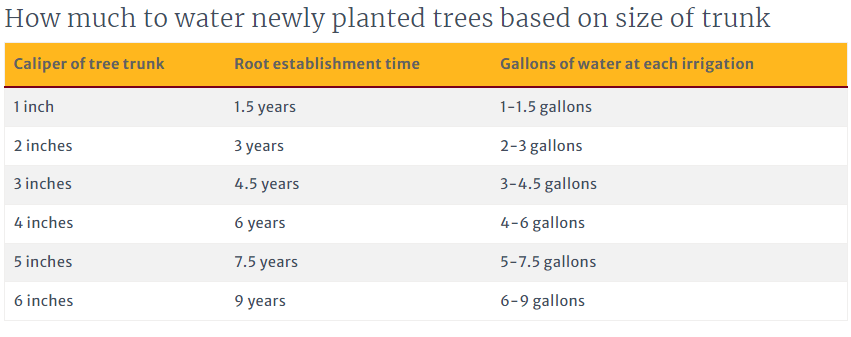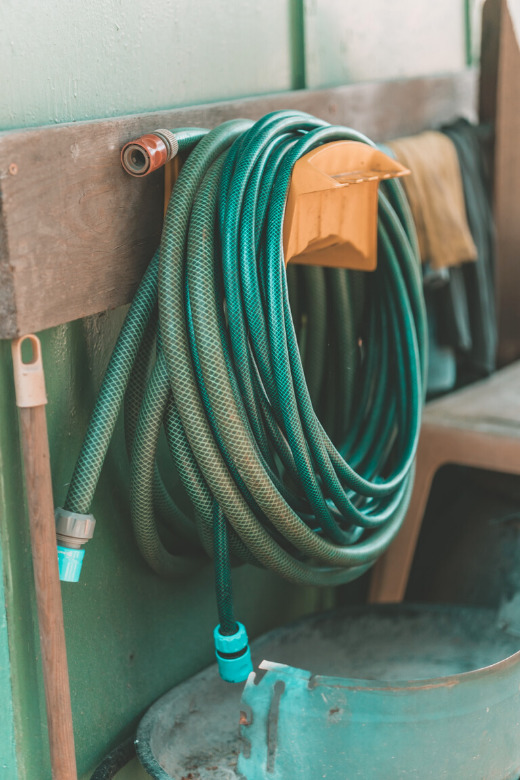Adding a new tree to your landscape is an important contribution to the future health of our planet. Trees are amazingly complex organisms that bring immense value to the areas where they grow.
Trees improve air quality by filtering contaminants from the air. They enhance water quality by reducing flooding and erosion. The evaporation from trees reduces the air temperature, providing important cooling effects to urban areas. And they provide important habitat and food sources for animals and insects throughout their local bioregion.
Planting new trees on our properties is extremely valuable to the ecosystems of our neighborhoods, communities and planet.
And like most living things, trees need water in order to survive and thrive. There’s often confusion around how often to water new trees, so in this article we’re going to clear up any misinformation and hopefully answer all of your questions about how and when to water trees (the right way).
Planting Trees the Right Way
Before we start talking about watering, let’s back up and talk about how to plant your trees correctly. Unfortunately, many homeowners, landscapers and other professionals are not educated in how to properly plant a tree in order to set it up for optimal growth and a long, healthy life, especially how seasons affect proper planting.
Trees are often planted too deep, metal cages and burlap bags are left on the root ball, and planting holes aren’t created large enough to encourage the tree’s roots to spread out. Planting a tree wrong is a tragedy in our book because you’re likely setting up the tree to fail long term.
Improper planting can stunt its growth, create girdling roots that eventually kill the tree, or prohibit the tree from reaching its full growth potential.
If you’re not sure how to plant your tree the right way, higher a certified arborist to plant for you or consult a reputable source for information, like the Arbor Day Foundation.
How Water Helps Trees Establish

Now that you’re certain your tree is planted in a way that will set it up for a long and healthy life, it’s time to talk about how often to water new trees.
Newly planted trees need regular and consistent watering. An adequate amount of water is critical to minimizing tree transplant shock and supporting the tree in growing a healthy root system. The right amount of water encourages the roots to grow more vigorously. As the root structure grows it’s able to hold more water and nutrients for uptake into the tree, allowing the tree to establish itself and eventually start putting on new growth.
When trees are dug up from the nurseries where they’re growing they undergo a great deal of trauma. When they’re being removed from the field the machinery prunes their root system, often leaving a large chunk of it in the soil. An important factor in helping newly planted trees get established as quickly as possible is encouraging the growth of their root system.
Eventually, the root system of the tree will grow to be much wider and more extensive than the visible canopy of the tree. Some studies have found that a tree that’s 6 inches in diameter at the trunk can have a root system that extends 19 feet out from the tree!
How to Water Newly Planted Trees
The amount of water a newly planted tree needs is highly dependent on many variables. Trees are influenced by environmental conditions like temperature, wind condition, and rainfall amount. And every tree is different due to variety, root development, and the soil type where it’s planted.
But, in most situations, these watering guidelines will make for a happy tree.
Frequency of Watering
- Water once every other day for two weeks following planting. On non-watering days, soil should retain moisture, but not feel soggy. The best way to check soil moisture is sticking a finger into the soil about 6” below the surface.
- After two weeks, water 2-3 times a week until dormant season (when deciduous trees lose their leaves).
- Continue watering 2-3 times during the growing season for 3-5 years, or until the tree is properly established.
If you live in a climate without regular rainfall, an area that’s experiencing drought, or a location that experiences extreme summer temperatures you should likely be watering more than the above frequencies. If your soil is sandy and doesn’t retain water (as opposed to clay soil that absorbs and holds water) you can also increase the amount and frequency of watering.
Volume of Watering
How much water to supply the tree each time you water depends on the size of the tree. The University of Minnesota Extension recommends calculating how much to water to use based on the size of the tree trunk.

When & Where to Water Your Tree
You want to always make sure you’re watering the roots of the tree. The trunk and leaves don’t need to be watered, so we don’t recommend using a sprinkler. Water in the morning or evening to reduce evaporation and conserve water. The best way to water is slowly. You want to make sure the entire root area is saturated.
If you have a hose that can reach the newly planted tree turn it on at a slow trickle and place the end of the hose in the area of the roots, pretty close to the trunk in young trees. Set a timer for about 30 minutes depending on the flow.
You could also use a soaker hose placed in a circle around the base of the tree.
Alternately, if you’d like to be more exact, you can turn your hose (or soaker) on a slow trickle and time how long it takes to fill up a bucket to your desired amount of gallons based on the table above.
If you have trouble remembering to water landscape plants, consider purchasing and using a Treegator, which will slow release water to the tree over a longer period. When it’s empty it will also serve as a handy visual cue to remind you to fill it up again.

Risks of Overwatering
Bear in mind that it is possible to overwater new trees. This is problematic, as new trees need to establish a healthy root system. If the soil is too saturated it can become anaerobic, or lacking oxygen. Roots need oxygen in order to respirate, which is an important metabolic process.
Remember to skip rainy days on your watering schedule. If your soil starts to stink, it may very well be anaerobic.
How long does it take for trees to get established?
Trees are considered established when the size of their root system equals the spread of the canopy. Of course, there’s no way to see how big the root system is, so we generally use the guideline that the bigger the tree the longer it takes to become established.
Trees that are 2 inches or less in caliper (the width of the trunk across, not the diameter) will take about three years to establish, 3-4 inch caliper four to six years, and 5-6 inch caliper seven to nine years.
Other Ways to Extend Your Tree’s Longevity
- Mulch ring: We highly recommend adding a mulch ring immediately after planting. This reduces water runoff and helps the soil retain moisture between waterings. Mulch also eliminates competition from grass and weeds. You don’t want any other plants stealing the water that’s meant for your new tree!
- Soil nutrition injection: We love supporting newly planted trees with our custom nutrition blend that includes micronutrients and beneficial fungi mycorrhizae, which are proven to improve water and nutrient uptake from the soil.
Congratulation on planting your new tree and adding a valuable feature to your landscape! Now that you’re clear on how often to water new trees, you’re equipped to care for your trees in the best way possible.
Got more questions about helping your tree live a long and healthy life? Eco Tree is here to help! Schedule a consultation with us today to get started.







